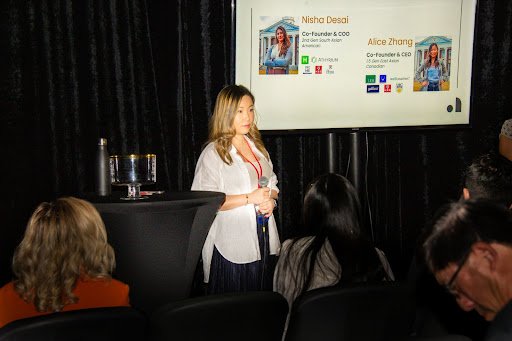Supporting Asian Mental Health
Earlier this year, we had the amazing opportunity to lead a workshop at the Asian Hustle Network Uplifted Conference in Las Vegas. We received great interest and feedback on the topic of destigmatizing mental health in our Asian American community; we believe that one of the best ways to do this is to break the silence through psychoeducation. And so, this post expands upon our discussion from the conference in an effort to continue raising awareness about Asian American mental health.
Historically and still today, the Asian American community is underrepresented in several areas, including but not limited to, the media, leadership, and positions of power, and in the conversation of racism. This not only emphasizes and continues the invisibility of our community but also undermines the real challenges around Asian American mental health experiences.
The American Psychological Association reports that Asian Americans are three times less likely to seek mental health care services compared to their White counterparts. Even more shocking, Asian Americans are the least likely of all ethnic groups to seek mental health care services. This extremely diverse group accounts for immigrants from over half of the globe, yet there has only been one research study completed, nearly two decades ago, on the prevalence of mental illness in the community. With 72% population growth from 2000-2015, there are a vast number of Asian Americans with mental health needs that are going unnoticed, unaccounted for, and unaddressed.
Racial Violence, Discrimination, and the Rising Demand for Mental Health Support
Now more than ever, the need for mental health care services among Asian Americans is clear and urgent when considering the drastic increase in racism and violence since the onset of the global COVID-19 pandemic. In the 30 years before the pandemic, reported anti-Asian violence amounted to a total of 210 violent attacks. From 2020 to 2021, a time span of just one year, 163 anti-Asian violent attacks took place: an 11x increase in violent, racially-charged violence against Asians. Moreover, these numbers are likely much higher in reality, as only 10%-30% of such crimes are actually reported.
Racism and violence, in addition to the general instability caused by the pandemic, experienced by Asian Americans and other communities of color have had a significant impact on mental health:
41% of Asian Americans currently experience symptoms of anxiety and depression
Those who experience discrimination are 2x more likely to report current depression and anxiety
Asian Americans have 1.24x odds of becoming depressed due to stress-related to acculturation
Suicide is the #1 leading cause of death among Asian young adults
It is important to recognize that racism and violence against Asian Americans is not a new concept: the pandemic only spurred the frequency and intensity of racism and violence that have been occurring for decades now. For instance, in the 1800s the United States enacted the Chinese Exclusion Act, which banned Chinese Immigrants from entering the United States. This legislation is the first and only time in the history of the United States where a specific nationality was explicitly refused entrance. As a result, many families were torn apart and Asian American businesses were closed down. Discrimination was also prevalent post 9/11 towards South and Southeast Asians in the forms of racism, xenophobia, and Islamophobia. As these three forms of hate and violence came together, Asian Americans’ religious buildings were vandalized, bigotry was rampant in schools and workplaces, and several community members were wrongfully murdered. While racism can take the form of physical aggression, as recently evidenced by the tragic killings of Christina Yuna Lee, Michelle Go, and the Laguna Woods Church members, verbal aggressions and microaggressions are extremely common and can be much subtler and unrecognizable if not taken with a critical lens. Microaggressions are often disguised as curiosities or compliments. For example, the common expression of “so where are you really from” assumes that the Asian person is not American, and instead, a perpetual foreigner in a country that the individual considers home. These little, seemingly harmless comments are equally detrimental to a person’s mental health as the other forms of racism and violence.
Unique Contributors to the Mental Health Challenges of Asian Americans
Aside from the pandemic, there are several other contributors and/or stressors that make the Asian American mental health experience unique, validating the need for culturally-responsive care models.
First, there is tremendous stigma in the Asian community attached to needing or receiving mental health care services. Being perceived as “weak-hearted” or “weak-minded” is not viewed as an appealing or tolerable trait in many Asian families, let alone actually admitting mental health problems to a stranger. In order to “save face” and preserve family dynamics, many Asian American community members may look first to families for help and delay seeking help until conditions worsen. In fact, one study of Asians with schizophrenia contained within the community revealed that they didn’t reach the mental health system until 3 years after initial onset of symptoms. The societal pressure to suppress or disguise negative feelings can also result in masking psychological decline with physical symptoms that have no organic cause. Discussion of physical symptoms, such as headache, fatigue and back pain caused by psychological distress, is relatively more accepted, often leading to mis- or under-diagnosis of the underlying mental illness. As such, careful and culturally-sensitive communication and psychoeducation is crucial to addressing deeply rooted stigma.
Intergenerational trauma and conflict also plays a role in Asian mental health. Parents and grandparents who immigrated to the US often carry remnants and reactions to political instability/persecution and economic hardships they endured when moving to a foreign country to begin their lives anew. More often than not, the trauma related to each of these endeavors are passed on to the children, and as a result, conflict can ensue in various forms and incompatible values can surface between children and parents. For example, a heavy emphasis is placed on academic success by previous generations to prevent their children from enduring similar hardships; however, this can deteriorate parent-child relations and is shown to increase the likelihood of anxiety or depression among Asian Americans.
Asian Americans, like other immigrant populations, experience a very unique stressor, called bicultural tension. Asian Americans are expected to navigate between two, almost polarizing, cultures: the traditionally collectivist Asian culture and the individualistic American culture. Asian cultures often value obedience to elders, conformity to social norms, hierarchical family structure, and emotional restraint. Having to manage affiliation with the Western majority culture while maintaining a minoritized identity adds a unique psychological and emotional burden on Asian American individuals that requires specialized care and attention.
Furthermore, a regular and frequent claim about the Asian American community is that they are all smart, successful, educated, living the American Dream and better off than most historically marginalized groups. This is commonly referred to as the Model Minority Myth. As a result of this idealistic view of our community, much of our mental health needs are invisible and disregarded with the assumption that we are happy, have access to resources and know how to utilize them. In actuality, these assumptions are far from the truth:
Myth: Asian Americans are high earning and well educated
Fact: Asian Americans have the highest economic disparity
Myth: Asian Americans face less systematic racism and discrimination
Fact: 32% of Asian Americans fear someone might threaten or physically attack them (this is the highest percentage of all ethnic groups)
Myth: Asian Americans are fairly represented in leadership positions
Fact: Asian Americans represent 3% of positions of power and <1% of elected officials, despite representing >8% of the overall population
And lastly, Asian Americans are often not included in external conversations surrounding racism, diversity, and equity, in part due to the model minority stereotypes described above. Asian American racism is frequently talked about as “not as bad”. These three words have come to be quite harmful as Asian Americans report feeling invisible, overlooked, and excluded. This gaslighting and lack of support can make mental health care services in this community seem unwarranted, but all the more necessary.
Where Can We Go From Here?
For Asian American community members, it is important to be aware of these facts, figures, and truths and to know that you are not alone. It is also important to be self-aware. Notice and know your body, mind, emotions and behaviors. Your body is your fuel and your power. Be kind to it by giving it your full attention. Begin by identifying symptoms and triggers of stress. Identify and develop your own coping skills and avoid any triggering places, emotions and situations. Learn to recognize and validate your emotions: Know that it is okay if things get difficult and recognize when you need a break to recharge and relax. Identify resources you trust and use them. This includes your family, friends, groups and communities, and de-stressing activities. If appropriate, seek professional health from culturally responsive services like Anise Health*, where you can be seen as a unique individual whose racial and cultural context shapes how you experience the world and how you want to live in the world.
As an ally, you can also play your part by stepping out of that comfort zone and trying one of the following calls to action:
Educate: do your best to stay informed about the news and culture - do not depend on marginalized groups to be the educator as it can be exhausting. A marginalized group or person always having to educate others about their ethnicity and culture time after time reinforces the notion that learning about these groups is not a commitment of the dominant culture.
Share: Spread awareness about the news and culture you learn about - this helps validate your colleagues, friends, and others’ discomfort and prompts a shift in behavior in the workplace and beyond.
Support: Subtle gestures go a long way - try checking in on a friend, ask them to grab coffee or lunch and, most importantly, be there and be present. In Asian culture, food is a common love language, so simply bringing them small snacks during a difficult time might be a more culturally-aligned way of expressing your support than asking bluntly about their feelings.
Remember, small steps forward are just as significant and contribute just as much to the process of change
* Looking for culturally-responsive mental health support? Anise Health is going live in California this week and will be accepting new clients from the Asian American community. If you’re interested, sign up for the email list on our website to be the first to know how to get started.



